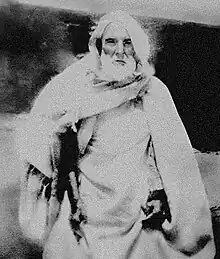Muhammad ibn Ali al-Sanusi
Muhammad ibn Ali as-Senussi (Arabic: محمد بن علي السنوسي; in full Muḥammad ibn ʿAlī al-Sanūsī al-Mujāhirī al-Ḥasanī al-Idrīsī) (1787–1859) was an Algerian Muslim theologian and leader who founded the Senussi mystical order in 1837. His militant mystical movement proved very significant and helped Libya to win its freedom from Italy on 10 February 1947. Omar Mukhtar was one of the most significant leaders of the Senussi military campaign launched by Muhammad ibn Ali as-Senussi. Al-Sanūsī's grandson Idrīs I ruled as king of Libya from 1951 to 1969.[1]
| Muhammad Ibn 'Ali Al-Senussi | |
|---|---|
| Founder of the Senussi dynasty | |
 | |
| Successor | Prince Muhammad |
| Born | 1787 Mostaganem, Ottoman Algeria |
| Died | 1859 Jaghbub, Libya, Ottoman Tripolitania |
| House | Senussi |
| Father | Ali as-Senussi |
| Religion | Islam |
Life
Al-Senussi was born in al-Wasita near Mostaganem, Algeria,[2] and was named al-Senussi after a venerated Muslim teacher. He was a Berber of the Algerian Walad Sidi Abdallah tribe who claimed descent from the prophet Muhammad.[3][4][5] The family takes its name from a religious Sheikh named Sanussi who lived in Tlemcen during the 13th century.
Unable to cross Algeria because of the French occupation, the beginning, the centre of Imam Mohammed Ali El Senussi's call was Jebel Akhdar and he built a mosque in Bayda of Cyrenaica and named it after himself, then he moved to Jaghbub in Cyrenaica from where the mosques spread to the remaining cities of Barqa and Tripoli.[6]
He built a great mosque and a university, which was shut down on the orders of Muammar al-Gaddafi in 1984; at the same time, the graves and remains of the Senussi family were desecrated. After the death of Muhammad as-Sanussi his son Muhammad al-Mahdi as-Senussi (1859–1902) became the new leader of the Senussi order, and moved it south from Jaghbub to Kufra.[2] His grandson through Muhammad became King Idris, the only King of Libya.
| Muhammad ibn Ali as-Senussi | |||||||||||||||||||||||||||||||||||||
| Muhammad as-Sharif as-Senussi | |||||||||||||||||||||||||||||||||||||
| Muhammad al-Mahdi bin Muhammad as-Senussi | |||||||||||||||||||||||||||||||||||||
| Ahmed as-Sharif as-Senussi | Muhammad al-Abid as-Senussi | ||||||||||||||||||||||||||||||||||||
| Muhammad ar-Reda | King Idris I of Libya | Queen Fatimah as-Sharif | az-Zubayr bin Ahmad as-Sharif | Abdullah bin Muhammad al- Abid as-Senussi | |||||||||||||||||||||||||||||||||
| Hasan as-Senussi | Ahmed as-Senussi (member of NTC) | Idris bin Abdullah as-Senussi (claimant) | |||||||||||||||||||||||||||||||||||
| Mohammed as-Senussi | |||||||||||||||||||||||||||||||||||||
See also
References
- S. Khuda Bukhsh, Studies Indian and Islamic, Routledge 2001, p. 28 ISBN 0-415-24464-1 (retrieved 26-09-2011)
Notes
- "Al-Sanūsī | Islamic religious leader". Encyclopedia Britannica. Retrieved 2018-08-10.
- Shillington, Kevin (2005) "Libya: Muhammad Al-Sanusi (c.1787–1859) and the Sanusiyya" Encyclopedia of African History Fitzroy Dearborn, New York, p. 830-831, ISBN 1-57958-245-1
- Juan Eduardo Campo (2009). Encyclopedia of Islam. Infobase Publishing. p. 443. ISBN 978-1-4381-2696-8.
- Paolo Sensini (2016). Sowing Chaos Libya in the Wake of Humanitarian Intervention. SCB Distributors. p. 15. ISBN 978-0-9860853-8-3.
- MARTIN, B. G. (1992). "A FUTURE SANUSI CALIPHATE? MUHAMMAD ʿALI AL-SANUSI AND HIS "DURAR AL-SANIYA"". Journal of Asian History. 26 (2): 160–168. ISSN 0021-910X. JSTOR 41930867.
- The Senussi Family Archived 2012-12-26 at the Wayback Machine Retrieved 1 October 2011.